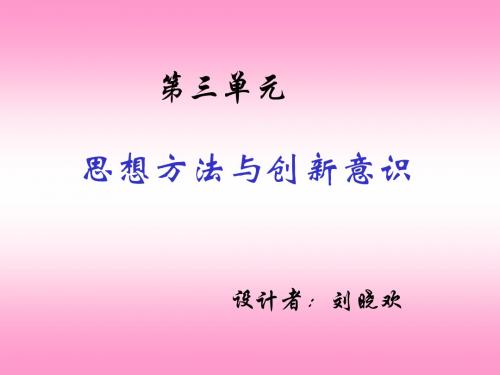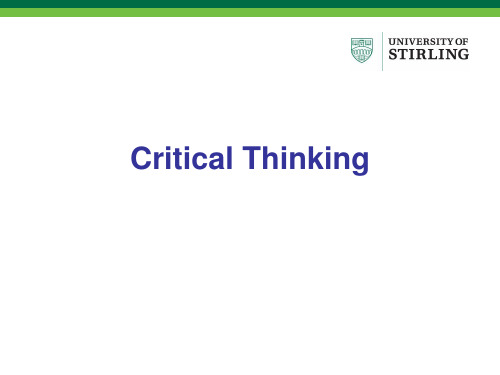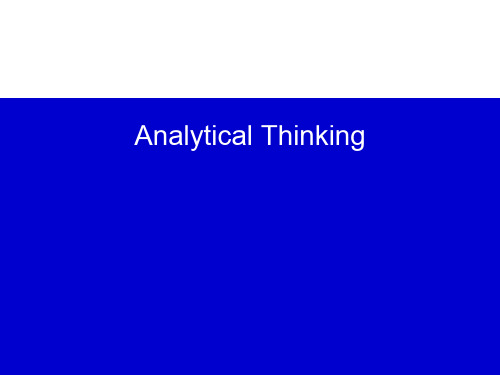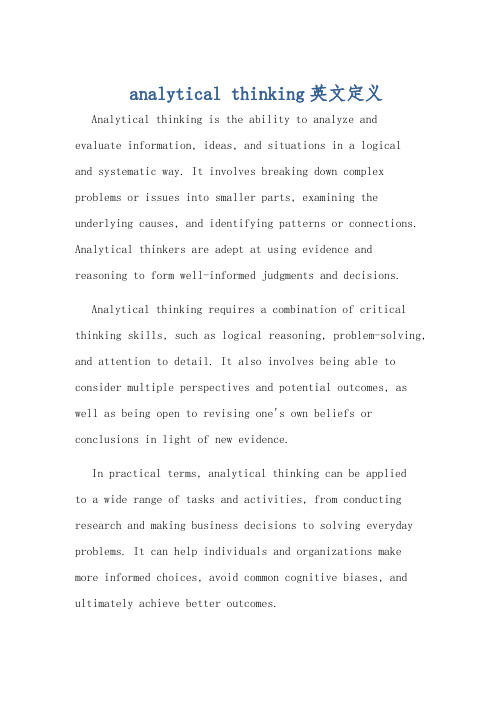AnalyticalThinkingPPT教学课件
lecture 2 critical thinking批判思想PPT课件

Para. 6: Our future as a species is dependent on whether we can develop the wherewithal to raise our collective thinking so as to produce positive changes in societies across the world.
6
Part IV (Paras. 11 – 12): How do we cultivate critical thinking?
This can be done only person-byperson through a process, which we call intellectual work. Think of the “Elements of Thought” ... Are we in the habit of asking questions?
be divided into?
2
Text 1 Critical Thinking
Part I: (Paras. 1 – 4) What is critical thinking? (definition)
Para. 1: It’s a system for opening every existing system.
8
The last two paras.: conclusion Our students should learn to think
思想方法与创新意识PPT课件 人教课标版

矛盾的斗争性: 是指矛盾双方相互排斥、相 互对立的属性。矛盾的同一性和 斗争性不可分割。
2.矛盾的普遍性和特殊性 (考点) 知识点
矛盾的普通性是指矛盾存在于一 切事物中,并贯穿于每一事物发展过 程的始终。 承认矛盾的普遍性:是坚持唯物 辩证法的前提。我们要承认矛盾,分 析矛盾,敢于揭露矛盾,积极寻找正 确的方法解决矛盾。
1.发展的前进性与曲折性 (考点) 知识点
(2)事物发展的道路是曲折的。
2.发展的量变与质变状态 (考点) 知识点 量变是指事物数量的增减和 场所的变更,是一种渐进的。不 显著的变化; 质变是指事物根本性质的变 化,是一种根本的、显著的变化。
(5)唯物辩证法的矛盾概念
考点: 矛盾的同一性和斗争性[p113
3.联系的多样性 (考点) 知识点
(3)用联系的观点看问题
考点:
整体和部分的关系[p109 1.] 系统优化方法[p110 2.]
1.整体和部分的关系 (考点) 知识点
(1)整体和部分相互区别。 整体是事物的全局和发展的全过程,部 分是事物的局部和发展的各个阶段。 整体和部分在事物发展过程中的地位、 作用和功能各不相同。整体居于主导地位, 统率着部分,具有部分不具备的功能;部 分在事物的存在和发展中处于被支配的地 位,从属和服务于整体。
A①②③④ C②③④
C
B①②③ D①③④
13.在下列有关联系、运动、变化、发展的相互关 系选项中,正确的有(ACD) ①任何事物和周围其他事物都是在运动、变化和 发展过程中发生联系的 ②运动是指空间位置的移动;变化是指事物循环 或倒退运动;发展是事物向前或上升的运动 ③发展是一种运动变化,但并不是一切运动、变 化都是发展 ④运动、变化和发展都是由事物内部各要素和事 物之间相互作用、相互影响而引起的
criticalthinking阅读时的批判性思维(共25张PPT)

The last two paras.: conclusion
Our students should learn to think critically so as to know how to change their thinking in keeping with the changes of the world.
• 'Being critical' in academic terms refers to two broad characteristics of a researcher's way of thinking.
1. A critical researcher is always questioning.
Para. 2: Or, critical thinking is thinking that analyzes thought, that assesses thought, and that transforms thought for the better.
Para. 2: (There is a third way to talk about
Paras. 13 – 15: What standards do you use to assess your thinking and the thinking of others?
“I use the standards of clarity, accuracy, precision, relevance, depth, breadth, logic and fairness.”
generalizations Part III: (Paras.
carefully about what you read and 6: Our future as a species is dependent on whether we can develop the wherewithal to raise our collective thinking so as to produce positive
促进评判性CriticalThinking思维能力71页PPT

45、自己的饭量自己知道。——苏联
41、学问是异常珍贵的东西,从任何源泉吸 收都不可耻。——阿卜·日·法拉兹
42、只有在人群中间,只需要教育; 而要挑战别人所说的话,则需要头脑。—— 玛丽·佩蒂博恩·普尔
促进评判性CriticalThinking思维能力
6、法律的基础有两个,而且只有两个……公平和实用。——伯克 7、有两种和平的暴力,那就是法律和礼节。——歌德
8、法律就是秩序,有好的法律才有好的秩序。——亚里士多德 9、上帝把法律和公平凑合在一起,可是人类却把它拆开。——查·科尔顿 10、一切法律都是无用的,因为好人用不着它们,而坏人又不会因为它们而变得规矩起来。——德谟耶克斯
critical thinking ppt

Critical Thinking
Critical thinking is the ability to think clearly and rationally. It includes the ability to engage in reflective and independent thinking. Someone with critical thinking skills is able to do the following : • understand the logical connections between ideas • identify, construct and evaluate arguments • detect inconsistencies and common mistakes in reasoning • solve problems systematically • identify the relevance and importance of ideas and to reflect on the justification of one's own beliefs and values
Turning research ideas into research projects
• Writing objectives
–To identify the advantages and disadvantages –Looking for the facts and data on the influence on publishing companies and readers
What are the advantages of not having standard e-book format? What are the disadvantages of not having standard e-book format? Have publishing companies been effective? Have e-book reader been effective?
Analytical Thinking Training

Getting to the "RБайду номын сангаасot" of the Problem
• Sometimes the thing we think is a problem is not the real problem, so to get at the real problem, probing is necessary • Root Cause Analysis is an effective method of probing – it helps identify what, how, and why something happened • Definition of root cause: – Specific underlying cause – Those that can reasonably be identified – Those that management has control to fix
Analytical Thinking
Outline
I. II. III. IV. V. VI.
Overall Process Defining the Problem Formulating the Hypothesis Collecting the Facts Conducting the Analysis Developing the Solution
Conducting the Analysis
Definition: • The deliberate process of breaking a problem down through the application of knowledge and various analytical techniques Importance: • Analysis of the facts is required to prove or disprove the hypotheses • Analysis provides an understanding of issues and drivers behind the problem Basic Concepts: • It is generally better to spend more time analyzing the data and information as opposed to collecting them. The goal is to find the “golden nuggets” that quickly confirm or deny a hypothesis • Root cause analysis, storyboarding, and force field analysis are some of many analytical techniques that can applied
新教材高中政治第11课创新思维要善于联想第2框联想思维的含义与方法pptx课件部编版选择性必修3

事实相反的情况作为事物发展的 联系方式认识的局限性,帮助人们创
一种条件,仿照事物之间的条件 造出多种多样的“虚拟世界”,丰富 关系,推测事物发展的可能前景 人们的__认__识__内__容___和精神世界
(5)作用:想象可以帮助人们明确创新思维的__目__标____,可以促使人 们以更高涨的热情和坚忍的意志投入创新活动之中。
(2)生理基础:人的大脑会根据主体的__需__要___、兴趣、_知__识__结__构__、 个人经历等,将其对事物的认识进行__归__档___,分门别类地储存在记忆 之中。当主体面临需要解决的问题时,大脑会根据问题的__性__质___,利 用某种契机,对相关事物的认识进行__联__结___,产生回忆,在触类旁通 的探索中寻求问题的解决。
知识点 二 联想思维的方法
1.迁移 (1)地位:是联想思维的“__联__结___”方式。 (2)含义:联想思维中的迁移,是将不同认识对象的性质、作用等进 行__位__置__变__迁___与___功__能__移__植__,以寻求解决问题的新思路。 (3)作用 ①迁移可以为创新思维开拓可能的__思__路___。只有将过去的经验和 认识运用到新情况和新问题之中,才能开辟认识新情况、解决新问题的
核心素养•提能力
议题 联想思维的含义
议题导引 一家玩具公司,从“克隆羊”多利得到启发,推出一个活动,顾客 只要将一张自己女儿的彩照和一份反映女儿特征的表格寄给公司,该公 司便会给顾客做一个和照片一模一样的玩具娃娃。该活动取名为“孪生 姐妹”,自此公司生意兴旺。
[探究] (1)这家玩具公司的做法得益于什么思维形式? (2)这家玩具公司为什么能完成这种思维方式? 提示:(1)是联想思维,许多新的创造都来自人们的联想。 (2)①联想思维具有跨越的联结性。联想思维的“联”就是把对性质 相同、相似甚至不同的事物的认识联结起来,建立新的关联,产生新的 观念。这家玩具公司将相关对象的认识联系在一起,其联结方式具有非 连续的跨越性。②联想思维具有非逻辑制约的畅想性。这家玩具公司就 是发挥了非逻辑制约的畅想性。
思想方法与创新意识复习PPT课件 人教课标版

第四单元
整合教材的智慧
唯物辩证法 的联系观
世界是普遍联系的
用联系的观点看问题 世界是永恒发展的 用发展的观点看问题 矛盾是事物发展的源 泉和动力
联系的普遍性 联系的客观性 联系的多样性
坚持整体与部分的统一 掌握系统优化的方法 发展的普遍性 发展的实质
唯物辩证法 的发展观 第三单元 唯物辩证法的 实质与核心
承认矛盾………
否认矛盾……
教学素材:
南隐斟茶 建设创新型国家 创新与马克思主义中国化 视频材料: 阿凡提染布 社会主义新农村——华西村的发展
说说看
毛泽东思想
邓小平理论
“三个代表”重要思想 科 学 发 展 观
马克思主义中国 化的哲学依据是 什么?重大意义 是什么?
党的十七大报告明确指出:“提高自主创 新能力,建设创新型国家。这是国家发展 战略的核心,是提高综合国力的关键。” 为什么中国创新型国家?其哲学依据是什 么?其重要意义何在?
第八课 唯物辩证法的发展观
发展
正确理解发展 的实质
(事物的前进和上 升,新事物的产生 和旧事物的灭亡)
判断新旧事物的根本 标准
(三个是否 克服三种错误标准)
事物是变化发展的原理
一切事物都处在永不停息的运动、变化和发 展的过程中,整个世界就是一个无限变化和 永恒发展着的物质世界,发展是新事物代替 旧事物的过程。
前途是光明的 道路是曲折的
做好量变的准备 促进事物的质变 矛盾的同一性和斗争性 矛盾的普遍性和特殊性 坚持两点论与重点论的统一 具体问题具体分析 辨证否定观与创新意识 辩证法的革命批判精神与创新意识
用对立统一的观点看问题 树立创新意识是唯 物辩证法的要求 创新是民族进步的灵魂
Critical Thinking Part I批判性思维 ppt课件

• Vanessa
• Andy
• Michael
18
Categorizing
19
Categorizing
20
Categorizing
21
Pond Indian Lair Biology Creates Decide Never
Categorizing
Lake
Sea
Irish
Iranian
Den
• selecting the best examples;
reflective thinking focused on deciding what
• and providing evidence to illustrate your argument. p. 9 to believe or do”
Total
300 points
Reminder: Late work WILL NOT be accepted for a grade
4
Warm-Up
Without talking, you must arrange yourselves from oldest (at the front of the class) to youngest (at the back of the class). Be as precise as possible.
Homework
60 points (7 6-point assignments; 2 14-point assignments)
Quizzes
90 points (30points of Pop Quizzes; 2 30-point take home exams)
Final Exam 120 points (Comprehensive Final)
ThinkingCritically批判性思维PPT教学课件

2020/12/10
7
Thinking critically
Native speakers question authority, but how?
▪ In many cultures, the point of speaking in public or writing for an audience is:
– to imitate the style of famous orators and writers
▪ Native speakers of English expect writers to be
Look at the author’s ideas and determine - The author’s credibility - Whether the ideas are logical
2020/12/10
8
Thinking critically
▪ Keep an open mind ▪ Withhold judgment ▪ Realize your own limitations and biases ▪ Consider other people’s reactions and
2020/12/10
5
Speak or Write with a native style
▪ Question authority
▪ Native speakers of English assume they are operating within a democratic society that encourages open debate.
analytical thinking英文定义

analytical thinking英文定义Analytical thinking is the ability to analyze and evaluate information, ideas, and situations in a logicaland systematic way. It involves breaking down complex problems or issues into smaller parts, examining the underlying causes, and identifying patterns or connections. Analytical thinkers are adept at using evidence and reasoning to form well-informed judgments and decisions.Analytical thinking requires a combination of critical thinking skills, such as logical reasoning, problem-solving, and attention to detail. It also involves being able to consider multiple perspectives and potential outcomes, as well as being open to revising one's own beliefs or conclusions in light of new evidence.In practical terms, analytical thinking can be appliedto a wide range of tasks and activities, from conducting research and making business decisions to solving everyday problems. It can help individuals and organizations make more informed choices, avoid common cognitive biases, and ultimately achieve better outcomes.Developing strong analytical thinking skills involves practice and training. This can include activities such as solving puzzles, engaging in debates, or working on complex projects that require careful analysis and evaluation. It also involves being open to feedback and actively seeking out new information and perspectives.In conclusion, analytical thinking is a vital skill that allows individuals to effectively process and evaluate information, make sound decisions, and solve problems. It is an essential component of critical thinking and is crucial for success in both professional and personal endeavors.分析思维是以一种逻辑和系统的方式分析和评估信息、想法和情况的能力。
- 1、下载文档前请自行甄别文档内容的完整性,平台不提供额外的编辑、内容补充、找答案等附加服务。
- 2、"仅部分预览"的文档,不可在线预览部分如存在完整性等问题,可反馈申请退款(可完整预览的文档不适用该条件!)。
- 3、如文档侵犯您的权益,请联系客服反馈,我们会尽快为您处理(人工客服工作时间:9:00-18:30)。
Able to discern his/her progress after thinking
Practices and observes thinking
Operating skill + intelligence + experience
2020/12/09
3
PMI
P
plus or good points
M
minus ing points
Two or three minutes to deliberately think through a problem or situation.
2020/12/09
8
DeBono’s Characterization of a Good Thinker
Has a clear focus and a broad view of the
situation Values wisdom over cleverness Likes thinking even when it isn’t
2020/12/09
10
Levels of Thinking
Knowledge: recalling information; repeating information with no changes
(ex: recalling dates; memorizing definitions for a history exam)
2020/12/09
5
Attitudes Plus Action Equals Success
The Attitudes
Greet problems as challenges and not as threats Tolerate uncertainty
Engage in self-evaluation and criticism Engage in divergent thinking Persevere
2020/12/09
4
Creative Problem Solving
Recognize the problem Define the problem Gather ideas or data Rank ideas Test the ideas Draw conclusions Evaluate conclusions
Analytical Thinking &
Problem Solving
The University of Tennessee Student Academic Support
Services
2020/12/09
1
Overview
1. Creative Problem Solving 2. Critical Thinking- Attitude 3. Models and methods on problem solving 4. Challenges and exercises on problem
Not that he/she is right or even that he/she can find
the answer but that he/she can turn on his/her thinking at will and deliberately focus it in any direction he/she wants.
Systematically and deliberately approach task Are Flexable
2020/12/09
6
Attitudes Plus Action Equals Success
The Actions
Brainstorm and search all possibilities Attend to details Set plans of action
Comprehension: Understanding ideas; using rules and following directions
(ex: explaining a mathematical law; knowing how the human ear functions; explaining a definition in psychology)
Question continuously Check for accuracy
Break problems into pars Avoid Guessing
2020/12/09
7
DeBono’s Characterization of a Good Thinker
Confident in his/her thinking
solving
2020/12/09
2
Introduction
Intelligence = Good Thinking Skills
“Thinking is the operating skill with which intelligence acts upon experience for a purpose.”
particularly successful Confident and decisive but humble
2020/12/09
9
DeBono’s Characterization of a Good Thinker
Robust in thought but practical were this is demanded
In control of his/her thinking
Does not drift from idea to idea or emotion to emotion
Has a clear idea of what he/she wants to do
Defines the thinking task and then sets out to carry it out
